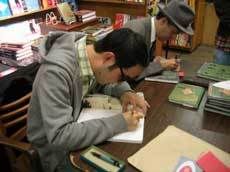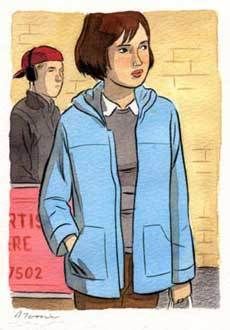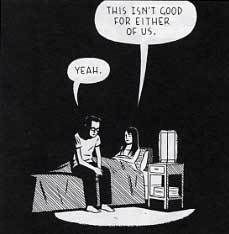DISCUSSION / BOOK SIGNING - Nov. 5 - Skylight Books I first saw Adrian Tomine's art at the GR2 gallery on Sawtelle. GR2 is one of Giant Robot's many storefront operations these days. Besides running interesting interviews with Japanese, Hong Kong or Korean filmmakers, Giant Robot succeeds, like any good art and culture magazine should, in occasionally turning my head slightly to catch something new on the passing cultural landscape.
I first saw Adrian Tomine's art at the GR2 gallery on Sawtelle. GR2 is one of Giant Robot's many storefront operations these days. Besides running interesting interviews with Japanese, Hong Kong or Korean filmmakers, Giant Robot succeeds, like any good art and culture magazine should, in occasionally turning my head slightly to catch something new on the passing cultural landscape.
That's exactly what happened when I walked into the Adrian Tomine show last summer. I saw a wall of 20-30 ink and watercolor panels that were as detailed in their capture of emotion as photography is, yet simplified in their high-contrast style of line drawing. They were like snapshots of people caught unobserved in mundane daily activity, whose faces revealed something about what they were thinking. Tomine struck me as an eavesdropping doodler, with a flare for capturing the expressions of people-in-passing. On some of Tomine's panels, he would scribble an impression or additional detail about the people he was spying on. "Deep in thought (or maybe just staring at his expensive-looking shoes," is written over a guy riding the train. "Making subtle facial reactions as one Wall Street guy explains to another his plan for 'scoring' with his ex-girlfriend when she comes to visit," reads the text beside a weary looking woman trapped between two jovial men. 

I suppose the ostensible filmmaker in me appreciated the panels not only for their visual qualities, but for their stripped-down storytelling. Each one seemed like a micro-world of one or several characters, colored in their distraction or anxiety, with the past or future glazed into their eyes or reeking off their clothes.
I would have loved to walk out with one or more of these little ink panels, but each was attached to a price tag of $200-$400. Although I believe in "supporting the arts," I have never "owned art." Not the high-priced one-of-a-kind variety. So, bumbling around the store, I came across Optic Nerve - Tomine's comic book.
To anyone unfamiliar with the current state of comics, Optic Nerve might come as a complete departure from the expected. Super-heroes are still the driving force in that end of the publishing industry, but there has been a growing niche of illustrated fiction, autobiography and even journalism in comics that goes back at least 20 years to works like the Hernandez Bros.' Love and Rockets. Optic Nerve continues that tradition.
I am actually not well-versed in the existing body of comic literature out there. Having never been much of a comics reader as a kid, I did not naturally gravitate towards "adult comics." Many comics readers would mark the publication of Alan Moore's Watchmen and Frank Miller's Dark Knight Returns as key moments in the evolution of "adult comics." Each put a post-modern spin on super-heroes, exploring real psychology, politics and graphic violence. They were not simple, innocent tales of heroism. The adult "superhero" that emerged in the following years was more often than not an "antihero," the protagonists and antagonists of these stories each had a moral yin and yang. The gradual over-arching trend which culminates in works like Optic Nerve shows a move away from mythic characters altogether.
Optic Nerve is mostly populated with people in their 20s, living in and around Oakland and Berkeley, who have unhappy or awkward relationships. It does not tell one continuous story, but is a collection of short vignettes that read like fleshed-out forays into the worlds of Tomine's ink drawings and watercolors. They're great short fiction, small slices of mood, with an authenticty that feels autobiographical. Initially I picked up Issue #1 as an affordable way to take home some of Tomine's drawings, but I found the stories, with their occasional cliff-hanger endings which emphasized mood over narrative, to be addictive. I have scooped up the remaining issues in print (Drawn and Quarterly is currently re-printing them all), but was surprised and frustrated to learn that there were only 9 issues in total. To add to my frustration, Issue 9 was the first of a serialized three-part story - a departure from the normal anthology format. 

Optic Nerve seems to have been an on-going project for Tomine since his late teens, when he published it himself. Since he has been signed to publisher Drawn and Quarterly, issues have appeared as seldom as once a year. Doing all the writing and art himself, in addition to making a living with illustrations for mainstream magazines like the New Yorker, doubtless slows down production time. So I was enthused to hear that Issue #10 was soon to be on shelves and Tomine would be making the rounds doing in-store appearances.
The event drew a sizable crowd. There was some discussion on the settings in which comics now find themselves, which was interesting to ponder as I took in the faces of LA hipsters and literati - this was not Comic-Con. Tomine remarked that comic book art is out of context when hung on the walls of a gallery. The art is the book itself, he argued, the painting or drawing done to make it just a part of the process in creating that piece of art. After a lot of talk about whether or not the work was autobiographical or not and what sources served as influences, I felt that was the nugget of the evening. Art might be commerce, as Warhol argued, but you don't always need to be in the company of the trendy or the well-dressed, drinking shitty wine and receiving disapproving glances to appreciate it. For two or three bucks you can read it a few times and still have the author sign the worn cover.
Interview with Adrian Tomine
NY Times article on graphic novelists
Online gallery of Tomine art for sale
My Top 11 Images Los Angeles 2019 (plus 5 I almost forgot about)
-
Here are some of my favorite photos I took during the last year in Los
Angeles.
Click the image to see at a larger size.
Ted
Photos by Ted Soqui © 2019
U...
4 years ago

